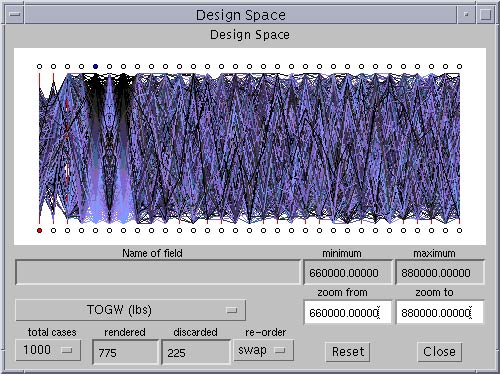

PSE Research Projects
VizCraft is a PSE that aids aircraft designers during the conceptual design stage. At this stage, an aircraft design is defined by a vector of 10 to 30 parameters. The goal is to find a vector that minimizes a performance-based objective function while meeting a series of constraints. VizCraft integrates simulation codes to evaluate a design with visualizations for analyzing a design individually or in contrast to other designs. VizCraft allows the designer to easily switch between the view of a design in the form of a parameter set, and a visualization of the corresponding aircraft geometry. The user can easily see which, if any, constraints are violated. VizCraft also allows the user to view a database of designs using the parallel coordinates visualization technique. VizCraft is a design tool for the conceptual phase of aircraft design whose goal is to provide an environment in which visualization and computation are combined. The designer is encouraged to think in terms of the overall task of solving a problem, not simply using the visualization to view the results of the computation.
VizCraft provides a menu-driven graphical user interface to the high speed civil transport (HSCT) design code that uses 29 variables and 68 realistic constraints. This code is a large (million line) collection of C and FORTRAN routines that calculate the aircraft geometry in 3-D, the design constraint values, and the take-off gross weight (TOGW) value, among other things. VizCraft displays the HSCT planform (a top view), cross sections of the airfoil at the root, leading edge break, and tip of the wing, and color coded (red, yellow, green) constraint violation information. To help manage the large number of constraints, they are grouped conceptually as aerodynamic, geometric, and performance constraints. Design points, and their corresponding TOGW, are displayed via active parallel coordinates. The parallel coordinates are also color coded, and they can be individually scaled, reordered, brushed, zoomed, and colored. A parallel coordinate display for the constraints can be similarly manipulated. While the integration of the legacy multidisciplinary HSCT code into a PSE is nontrivial, the strength and uniqueness of VizCraft lie in its support for visualization of high dimensional data (see Figure)
Last modified: November 5, 2001

